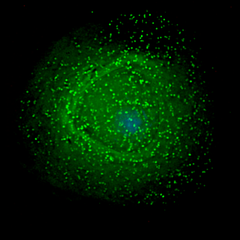Immune Cells Proposed as HIV Hideout Don't Last in Primate Model
 Where does HIV hide? Antiretroviral drugs can usually control the virus, but can’t completely eliminate it. So any strategy to eradicate HIV from the body has to take into account not only the main group of immune cells the virus targets, called CD4 or helper T cells, but other infected cells as well.
Where does HIV hide? Antiretroviral drugs can usually control the virus, but can’t completely eliminate it. So any strategy to eradicate HIV from the body has to take into account not only the main group of immune cells the virus targets, called CD4 or helper T cells, but other infected cells as well.New research from Yerkes National Primate Research Center, Emory University, sheds light on the question of which cells support viral replication and persistence, and the answers have implications for future efforts to eliminate HIV from the body in human patients.
The results were published in the journal PLOS Pathogens.
"Our results have implications for efforts to cure HIV," said lead author Mirko Paiardini, assistant professor of pathology and laboratory medicine at Emory University School of Medicine and Yerkes National Primate Research Center. "Our findings suggest that therapeutic strategies aimed at stimulating infected macrophages may facilitate viral elimination."
Researchers at Yerkes looked at what happens when rhesus macaques have CD4 T cells removed from their immune systems before infection by HIV’s cousin SIV. They found that another type of immune cell, called macrophages, then becomes heavily infected by SIV. Infected cells are present in lymph nodes, intestine and brain as well as in the blood.
However, the macrophages live shorter than expected based on previous research studies, which calls into question the idea that the macrophages could serve as a long-term hideout when someone is infected by HIV but receiving antiretroviral drugs.
"Among HIV researchers, there has been a lot of debate about the contribution of macrophages to the HIV reservoir," Paiardini said. "We show that in the absence of CD4 T cells, macrophages can be heavily infected by SIV, which supports a role for macrophages in viral infection. However, when infected at high levels, macrophages become short-lived cells in vivo, with an average lifespan of 1.3 days. Thus, if validated in the setting of HIV infection in humans, our data support a model in which macrophages do not constitute the long-lived reservoir (in order of weeks) that has been proposed."
The researchers also found evidence that in macaques with depleted CD4 T cells, SIV is infecting microglial cells in the brain, otherwise rarely seen.
Source: Emory University [1]